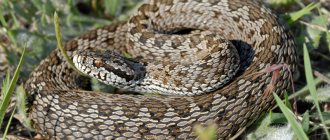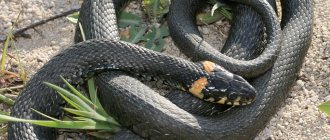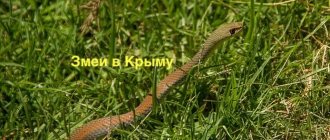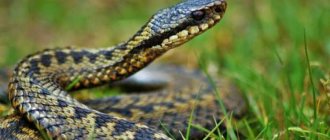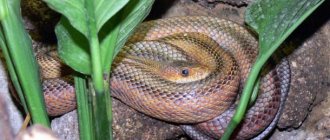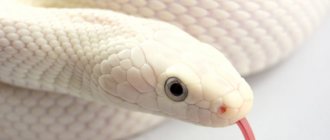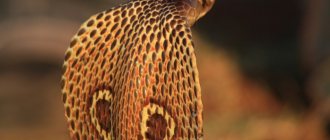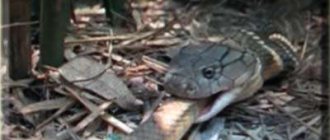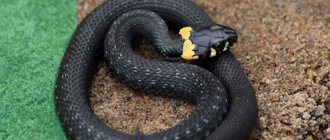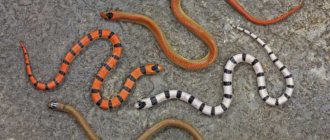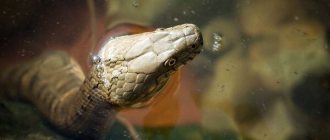The yellow-bellied snake is a snake whose appearance can frighten anyone. Therefore, it is not surprising that there are many interesting rumors around her. But what about the real facts? How well have scientists been able to study this representative of reptiles?
So, the good news is that there is a lot of verified information on this snake. Moreover, given its habitat, many works on its study were written by Russian researchers. Therefore, let's find out what they were able to reveal to us.
general information
The yellow-bellied snake is a snake representing the family of colubrids. True, unlike its closest relatives, it is capable of growing to gigantic sizes. There were cases when researchers found individuals whose length exceeded 2 m. Based on this, we can say with confidence that the yellow-bellied snake is the largest snake in Europe.
And besides, you can find it almost all over the continent, including in Russia. The Crimean yellow-bellied snake is especially interesting for scientists. This is due to the fact that there are quite a lot of them on the peninsula. And this allows you to observe snakes in their natural habitat without much effort and expense.
Yellow-spotted snakes masterfully catch and eat frogs and gobies
Crimea is home to species of snakes that are typical for central Russia, Ukraine, and Belarus. A good example is snakes. The common grass snake (Natrix natrix) is known to everyone. In color, it is a bright dark snake of medium size with characteristic light “ears” - spots of different shades of yellow or white on the sides of the head. It especially loves damp places, feeds on mice and frogs, and is not poisonous.
Its closest relative is the water snake (in the Sea of Azov in Crimea, Russia and Ukraine it is called the goby-snake ), even more firmly attached to water. It is somewhat lighter (gray or dark olive), and its “ears” are less noticeable. Even children 11-12 years old can catch it with their hands, if they switch from fear to the excitement of the hunt.
Snakes rarely bite, but if they do, it will be unpleasant. They are not poisonous, although their teeth are curved (to firmly hold captured prey) and can noticeably tear the skin. Caution: Snake teeth can become infected. But treatment then comes down to the usual disinfecting treatment of a small wound - hydrogen peroxide, iodine. It is much worse if the frightened one resorts to a “chemical attack.” In this case, he releases the contents of his intestines onto the offender. The smell is disgusting and cannot be removed by any means for a week or more.
Yellow-bellied snake: appearance
This snake has a very memorable appearance, and therefore it is simply impossible to confuse it with another species. Especially considering the size of the individuals, who have already reached the age of five.
So, the upper part of the snake has a dark color, which can vary from gray to brown, sometimes even black. In general, such changes depend on the snake’s habitat, because for it, skin is a natural camouflage that can hide it from prey. Therefore, you should not be surprised that representatives of the same species can be either gray or black.
What’s more important is that they all have yellow or orange colored undersides. In fact, because of this, the snake got its name - “yellow-bellied.” True, in small snakes these colors are still poorly expressed and can appear in the form of separate spots.
The scales have a clear cross-section, which makes the snake attractive in its own way. In the center of the scales are a little lighter, sometimes it even happens that they take on an orange tint. Because of this, they seem to shine, as if the sun's rays are playing on her skin.
The Rostov region is located in several natural, climatic and soil zones. We have a large area of forest-steppes (southwest, west and north of the region), steppes (southern and eastern parts of the region) and even semi-deserts (south-eastern part of the region). In each of these zones there live inhabitants familiar to the South of Russia - snakes. There are species that live throughout the Don Territory. And there are those who live only in certain natural areas. In total, 10 species of snakes are found in our region. The snakes of the Rostov region are our permanent, active and numerous neighbors.
In spring and summer, snakes are most active. How to identify a poisonous snake? How to stay calm and not get nervous when you see creeping reptiles? How not to make a harmless snake or snake crippled? Our article will answer all these questions. It is better to know snakes by sight, stay at the required distance and not harm them. We are glad if our material will help save people from herpetophobia (snake phobia) and serpentine illiteracy.
Fortunately, all poisonous species of snakes living in the Don Territory prefer to flee.
Safe for humans snakes in the Rostov region
1. Already ordinary.
The common snake is one of the most common snake-like inhabitants of the Rostov region. It is not poisonous and usually reaches a meter in length. But alas, too often falls victim to uninformed locals and uninformed tourists. Mistaking him for a viper, people kill him.
The ordinary one is harmless. It comes in different shapes and colors. The main distinguishing features are the characteristic “fish face” and large, round, dilated pupils. The third sign is the characteristic “yellow ears” on the head.
2. Already watery
Widely distributed in the Rostov region, especially in the Don Valley. Lives near bodies of water. Constantly becomes a prisoner of human fear and cruelty - the water snake is mistaken for the so-called “chess viper”, causing great damage to its population.
The merman is also not poisonous. He is afraid of a person and avoids meeting him. The color of the grass snake is dark gray or black, and most often there is a pattern of alternating light or dark stripes along the back. The eyes are round, fish-like, bulging. The merman spends most of his time in the water. It feeds on fish and small animals. Its dimensions can reach one and a half meters.
3. Medyanka
This is a small snake with a characteristic copper color, which is why it got its name. Its size does not exceed 75 centimeters.
This viviparous snake is conditionally poisonous - its venom only affects small animals and insects. Her teeth are hidden deep inside and the concentration of poison is minimal. It feeds mainly on insects, lizards, young snakes, and small rodents. Excessively timid.
Distributed throughout the Rostov region. But despite its wide range, the number of copperheads is rapidly decreasing. This is due to active human activity - arable land, plowing meadows, uprooting trees, etc. Belongs to a vulnerable species.
4. Yellow-bellied Snake
The largest snake in the Rostov region and throughout Europe. The length of an adult can reach 2.5 meters. Non-venomous. Belongs to a vulnerable species.
The yellow-bellied snake hunts what it can swallow. Its favorite prey is birds and small mammals. He does not disdain rats and mice, being the record holder for their destruction. It even attacks gophers and raccoons. The yellow-bellied snake usually swallows small prey alive. The larger one is crushed by its own weight, pressing it to the ground.
The yellow-bellied snake is often mistaken for a viper, although it is completely different from one. In addition, unlike the viper, which tries to hide from humans, the yellow-bellied snake will fight to the last, as it has an aggressive disposition. When trying to harm a snake, the yellow-bellied snake curls up into a ball and makes a two-meter throw, trying to hit the neck or face with its teeth. The maximum that it can cause is shallow wounds at the site of the bite. However, it has long been noted that all cases of snake attacks are provoked by man himself.
5. Four-striped snake
It is also a large snake – it can reach two meters in length. Not poisonous. It has a quiet and peaceful disposition.
In the Rostov region it lives in damp, shady areas - river beds, canyons and ravine forests. It can also be found on the edges and outskirts of groves, on rocky slopes overgrown with bushes. It takes refuge in rocky crevices, rodent burrows, and tree hollows.
Due to the illiteracy of local residents, it is often mistaken for a viper. Included in the Red Book of Russia.
6. Patterned runner
Another snake that is often given the mythically frightening name “chess viper.” Non-poisonous, non-aggressive and harmless. Due to aggression from local residents, its numbers are steadily declining. Also included in the Red Book of Russia.
Reaches a length of 1.5 meters. It has many colors and is characterized by their constant variability. This is an inhabitant of the Don forests - it lives mainly in trees, among dense foliage. Hunts for birds, chicks and bird eggs. It uses tree hollows, voids under roots, cracks in the soil and old stumps as shelters. Avoids meeting people.
Snakes dangerous to humans in the Rostov region
1. Steppe viper
The snake is small in size - reaches only seventy centimeters in length. This is a typical inhabitant of the steppes and semi-deserts of the region. It is found mainly in the eastern, southern and southeastern regions. This is a diurnal snake of open spaces. Its characteristic feature is a narrow eye pupil, a gray-sandy patterned body and a head shape characteristic of a viper.
Due to human economic activity, there is currently a sharp decline in its numbers. Until the early 90s, there was still a fishery for the venom of this snake, but today this species is listed under the protection of the Berne Convention. And according to a number of Russian scientists, the steppe viper is under threat of complete extinction.
The snake is poisonous. Quite shy - hiding from people. It attacks only when the path to retreat is cut off. But fatal cases of bites are unknown. Occasionally, horses and small livestock die due to the bites of the steppe viper. The venom of the steppe viper causes severe weakness, shortness of breath, chills, dizziness, bruising and bloody blisters in the bite area, and swelling. But this is not fatal - the victim usually makes a full recovery within a few days.
2. Common viper
The viper is medium-sized - can reach a meter in length. Its body is relatively thick, its head is rounded-triangular, clearly separated from the neck. The body color of the common viper can vary from dark gray or red-brown to beige. Its characteristic feature is the zigzag line running along its back. The design is completed by an X-shaped symbol on her head. The distribution area is mainly in the northern and northwestern regions of the region. Occasionally found in the central regions of the region. Viviparous.
The bite of a common viper is potentially dangerous to humans, but is extremely rarely fatal. People with allergies are primarily at risk - in this case, the effect of the poison can be unpredictable. The venom of the common viper is known to cause extensive hemorrhages and necrotic areas around the bite site, locally clotting the blood. Therefore, the closer the bite is to the head, the more dangerous it is. The person bitten may experience chills, dizziness, and severe weakness.
3. Black viper (Nikolsky's viper)
The most poisonous viper in the Rostov region. It reaches 85 centimeters in length and is distinguished by its “plumpness,” i.e. rather dense, heavy and wide, spindle-shaped body. It also differs from common and steppe vipers in the structural features of the scales and cornea of the eyes (the pupil is surrounded by a black-red eyelid or is almost invisible), and in its intense black color. Another interesting difference is that the tip of this snake’s tail can have a bright red tint.
Inhabits river valleys and along the banks of damp broad-leaved and shady ravine forests. It is distinguished by its zonality - it is found exclusively in the west, north and north-west of the Rostov region. It feeds on carrion, small mammals, frogs, birds, and baby snakes. It crawls slowly on the ground, but in terms of swimming speed it has no equal among the Don species. Listed in the Red Book of Russia.
The venom of the Nikolsky viper is extremely toxic. It has a targeted effect on stopping the heart muscle, as it contains a strong content of cardiotoxins mixed with hemorrhagic poisons. In terms of the degree of impact on humans, experts equate the venom of the black viper to the venom of a rattlesnake. The effect of Nikolsky's viper venom is accompanied by rapid heartbeat and convulsions. Fainting and coma are possible. Deaths are also common.
4. Cotton muzzle (Pallasov)
A dangerous species for humans from the genus Cottonmouth. Its range covers mainly the arid territories of Central Asia and the Caspian region. In the Rostov region it is represented locally, on the territory of the Salsk steppe and the southeastern regions - the driest and hottest. Pallas's copperhead prefers sun-warmed steppe territories and semi-deserts. Favorite food is rodents. It reaches 85 centimeters in length.
The genus received its name due to the unique shape of the head, covered with wide and strong bone growths. The cottonmouth is a pit snake, which means it can detect the presence of warm-blooded animals in complete darkness (the so-called biological thermal imager).
It has a gentle disposition, but when it needs to protect itself, it attacks a person. The sting of the copperhead is extremely painful. At the site of the bite and injection of poison, severe hemorrhages and hematomas occur, and large swelling forms around. In some cases, complete tissue necrosis is possible. But that’s not all. About an hour after the bite, the general neurotoxic effects of the copperhead venom appear, causing hallucinations and loss of consciousness. In the absence of medical assistance, complete paralysis of the respiratory system is possible. Scars from blood blisters and tissue necrosis can “decorate” the body of the bitten person for a long time.
———————————————— Dear readers! Remember that snakes, like dogs, sense adrenaline and perceive it as aggression. Don't let your time in nature be marred by killing or biting snakes!
Dmitry Kerasov
Similar
share
Where does this snake live?
Much can be said about this reptile only by hearing its full name - the yellow-bellied Caspian snake. It is not difficult to guess that you can meet it in almost all nooks and crannies of the Caspian basin. Especially in those regions where a warm and temperate climate prevails.
So, the yellow-bellied snake lives in Crimea, Hungary, Moldova, Romania, southern Ukraine and on the western coast of the Caspian Sea. It is also found in eastern countries such as Kazakhstan, Turkey, northern Iran and Azerbaijan. The yellow-bellied snake is found in small numbers on the islands of Tinos, Kythnos, Andros and Karpathos.
As for Russia, here it can be found in the Rostov region, Stavropol region, Volga region and in some other regions. The snake also lives in the foothills of the Greater Caucasus and near the borders of Dagestan.
Habits and customs of the yellow-bellied snake
This snake is not picky in choosing its habitat, the main thing is that it has enough warmth and plenty of food. Therefore, you can find its nest both in the open steppe and among mountain ledges. Although she still doesn’t like high altitudes too much, scientists believe that she rarely climbs above 1600 m above sea level.
She builds a nest among empty holes, small recesses, cracks in stones and even in tree hollows. It even happens that she takes the hole of her victim, occupying it along with all the good things. Although, of course, in such cases the former owner most often ends his life in the stomach of the snake.
The snake is not afraid of noise and people, so it can settle next to them. Many eyewitnesses claimed to have seen this careless reptile crawling into their backyard or garden day after day. Although such courage often ended sadly for her, because people do not really like such a neighborhood. And more than a dozen of these snakes have already died under the wheels of cars.
Hunting tactics and methods
The yellow-bellied snake is a very cunning and dangerous hunter, capable of attacking from an ambush. At the same time, it does not sting its victim, but squeezes it with its rings, like a boa constrictor. This grip can immobilize prey in a matter of seconds. And after the poor fellow who gets caught stops twitching, the snake calmly eats him.
And even if the prey somehow escaped the trap, it has very little chance of escaping from the yellow-bellied snake. Indeed, thanks to his muscles, he is able to develop great speed, with which almost no one is able to compete.
The snake prefers to hunt during the day, since at night its reaction decreases due to the drop in temperature. But if it’s very hot outside, then this tactic can change exactly the opposite.
Actions to take when encountering a snake
We must let her leave, which she will definitely take advantage of. If the attack occurred due to your carelessness (you stepped on a snake or picked it up with a stick), take any antihistamine. To avoid anaphylactic shock, inject tavegil solution (1-2 ml) under the skin, cutting into the wound from all sides. For severe symptoms, administer dexazone or dexamethasone (2-3 ml) intramuscularly, then take the victim to the hospital.
Attention. Do not suck out the poison (this is useless), do not cauterize or cut the wound, so as not to aggravate the death of tissue.
Keep the bitten limb immobile, drink 70 g of vodka/alcohol (this is a vasodilator), and drink plenty of diuretic liquid (herbal tea, beer, coffee), since the poison is excreted exclusively through the kidneys.
Return to content
Is this snake poisonous?
Many people are interested in the answer to this question. After all, I want to know how dangerous the snake is for others, especially for people. Well, like any representative of colubrids, the snake is devoid of deadly poison. Therefore, it does not pose a great danger to people.
Despite this, you need to be extremely careful with it. This reptile has a very bad character and is capable of attacking a person without a doubt, especially if he enters its territory.
In such cases, the yellow-bellied snake flares its tail, curls into a ring and jumps on the intruder. At the same time, he can perform a similar trick several times in a row, trying to overtake the enemy with all his might. It should be noted: although its bite is not fatal, it is still quite painful, especially for a child. Therefore, it is better to stay at a safe distance from this snake.
Lifespan and mating season
In general, the yellow-bellied snake can live up to 6-7 years. But few snakes reach this age, as they become victims of natural enemies and unforeseen circumstances. The greatest danger for them are martens and foxes, because for them the snake is a very pleasant treat.
At 3-4 years of life, these reptiles reach sexual maturity and go in search of a suitable mate. They mate at the end of spring, so that the babies probably have time to hatch from the egg and get stronger before the arrival of autumn cold weather. On average, one female produces 5-12 offspring.
In captivity, the snake feels much more comfortable, because here it is deprived of enemies. Therefore, such species are able to live up to 10 years and give birth to many more “heirs” at a time.
Forgetting caution
Soon after leaving the winter hut, which usually lasts from October to March, snakes begin to reproduce. During the mating season, these snakes are often found in pairs. During mating, the male holds the female by the neck with his jaws, while both partners lose their usual vigilance and caution.
At the end of June - beginning of July, a fertilized female, depending on age and size, lays from 6 to 20 eggs in a white soft leathery shell measuring 45 x 22 mm. The eggs lie in a dark, damp place: under fallen trees and stones, in abandoned rodent burrows, etc.
Young snakes, about 30 cm long, appear on the surface in early September. Readiness for reproduction occurs at the age of 3-4 years with a total body length of about 70 cm.
[custom_ads_shortcode3]
